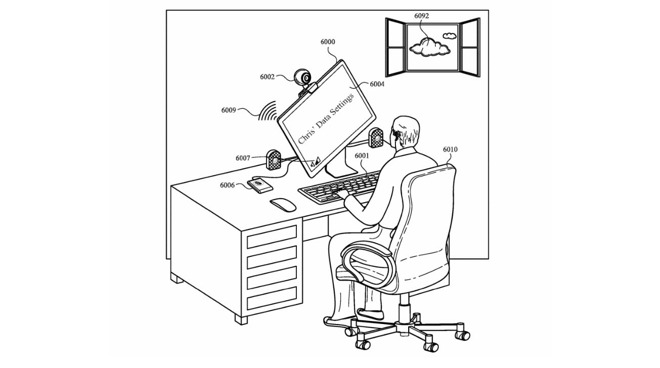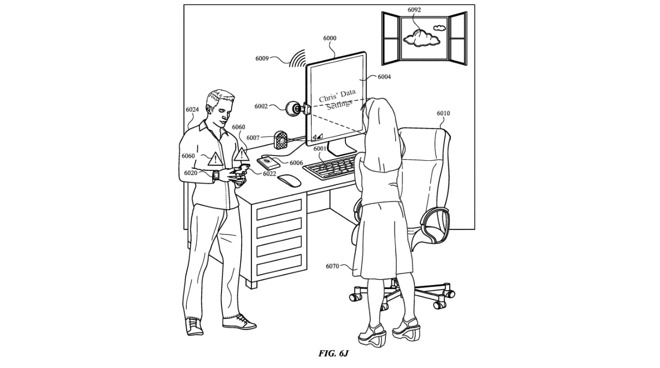Future iMac may pivot and rotate automatically for good ergonomics
A future iMac may automatically change the height and orientation of the display, as well as other settings depending on the logged-in user, in order to make the computing setup more ergonomic.

An example of a less-than-ergonomic workspace.
One of the factors affecting modern day computing is ergonomics, with users concerned about how they are sat and use a computing environment, to minimize any potential health issues from long-term use. While this has led to more ergonomic seating and standing desks, as well as a rising use of custom monitor arms and other peripherals, one of the unexplored areas is the computer and display.
Most of the time, the monitor is static and unchanging, maintaining position and orientation, as well as brightness and other attributes, regardless of the person sat in front of it. While a display can be configured to suit a person's preferences, they may not be ideal for a second user, and could prompt them to take time to make adjustments.
In the patent granted by the US Patent and Trademark Office on Tuesday titled "Ergonomic adjustments," Apple attempts to solve the problem by making the display change, depending on the current user of the Mac.
 A user logging in to a Mac may trigger an automatic reconfiguration of the display.
A user logging in to a Mac may trigger an automatic reconfiguration of the display.
In Apple's concept, a user can log in to an iMac using some form of authentication system, be it a username and password, biometrics, or some other system. Once logged in, the Mac then reads a file containing settings for the display intended for that user.
These settings can include things like brightness, contrast, and color profiles information, which could potentially be done purely in software, but there are other elements it also suggests. There is the proposal these settings could make changes to how the screen is physically oriented to the user.
In example images, this involves rotating the display from a landscape orientation to portrait, a maneuver that is typically performed manually, and would require the monitor to use motors. It would be feasible for the same sort of changes to affect other elements, including the height of the display to match the user's eye line, and how it is tilted.
 If a second known user is detected, the logged-in user may be asked if they will allow ergonomic changes.
If a second known user is detected, the logged-in user may be asked if they will allow ergonomic changes.
Following the initial authentication, the patent also handles if a different user sits at the desk instead of the intended user. In such cases, the system would prompt the logged-in user, possibly via an iPhone or Apple Watch message, that someone else is using their device.
A webcam would enable facial recognition of this second user, and if that person is known to the system, the first user could be asked if they will allow the system to change its orientation and ergonomic settings to match the second user's file. While changes could be made to the display's settings, the system could still allow the second user to have the access privileges used by the first, if they are still logged in.
While the example above deals with just the display, the claims of the patent talk in more general terms, which means it isn't much of a stretch to imagine it being used to adjust other things within a computing setup. For example, such a system could engage HomeKit and make adjustments to an office's local lighting to match the user's preferences.
There are also references in the patent to "keyboard modification settings," "chair and desk modification settings," as well as other elements using the height, weight, and age of the user.
The patent lists its inventors as Richard R. Dellinger and Marcel Van Os. It was originally filed on September 28, 2017.
Apple files numerous patent applications with the USPTO on a weekly basis, but while the existence of patents doesn't guarantee they will exist in a future product or service, they do indicate areas of interest for Apple's research and development teams.
Ergonomics have appeared a few times in Apple's patent history, such as 2011 filings where Apple envisioned full-hand multitouch displays using a curved surface. In September 2020, another patent envisioned a MacBook Pro with a hinged element, which could raise the keyboard and the display up to provide a more ergonomic angle for typing.
Apple has also looked into other unique designs for its products, such as a bendable MacBook that is made from a single piece of material. An iMac has also been proposed formed from a single sheet of glass, complete with a curved glass base and a wedge at the back.

An example of a less-than-ergonomic workspace.
One of the factors affecting modern day computing is ergonomics, with users concerned about how they are sat and use a computing environment, to minimize any potential health issues from long-term use. While this has led to more ergonomic seating and standing desks, as well as a rising use of custom monitor arms and other peripherals, one of the unexplored areas is the computer and display.
Most of the time, the monitor is static and unchanging, maintaining position and orientation, as well as brightness and other attributes, regardless of the person sat in front of it. While a display can be configured to suit a person's preferences, they may not be ideal for a second user, and could prompt them to take time to make adjustments.
In the patent granted by the US Patent and Trademark Office on Tuesday titled "Ergonomic adjustments," Apple attempts to solve the problem by making the display change, depending on the current user of the Mac.
 A user logging in to a Mac may trigger an automatic reconfiguration of the display.
A user logging in to a Mac may trigger an automatic reconfiguration of the display. In Apple's concept, a user can log in to an iMac using some form of authentication system, be it a username and password, biometrics, or some other system. Once logged in, the Mac then reads a file containing settings for the display intended for that user.
These settings can include things like brightness, contrast, and color profiles information, which could potentially be done purely in software, but there are other elements it also suggests. There is the proposal these settings could make changes to how the screen is physically oriented to the user.
In example images, this involves rotating the display from a landscape orientation to portrait, a maneuver that is typically performed manually, and would require the monitor to use motors. It would be feasible for the same sort of changes to affect other elements, including the height of the display to match the user's eye line, and how it is tilted.
 If a second known user is detected, the logged-in user may be asked if they will allow ergonomic changes.
If a second known user is detected, the logged-in user may be asked if they will allow ergonomic changes. Following the initial authentication, the patent also handles if a different user sits at the desk instead of the intended user. In such cases, the system would prompt the logged-in user, possibly via an iPhone or Apple Watch message, that someone else is using their device.
A webcam would enable facial recognition of this second user, and if that person is known to the system, the first user could be asked if they will allow the system to change its orientation and ergonomic settings to match the second user's file. While changes could be made to the display's settings, the system could still allow the second user to have the access privileges used by the first, if they are still logged in.
While the example above deals with just the display, the claims of the patent talk in more general terms, which means it isn't much of a stretch to imagine it being used to adjust other things within a computing setup. For example, such a system could engage HomeKit and make adjustments to an office's local lighting to match the user's preferences.
There are also references in the patent to "keyboard modification settings," "chair and desk modification settings," as well as other elements using the height, weight, and age of the user.
The patent lists its inventors as Richard R. Dellinger and Marcel Van Os. It was originally filed on September 28, 2017.
Apple files numerous patent applications with the USPTO on a weekly basis, but while the existence of patents doesn't guarantee they will exist in a future product or service, they do indicate areas of interest for Apple's research and development teams.
Ergonomics have appeared a few times in Apple's patent history, such as 2011 filings where Apple envisioned full-hand multitouch displays using a curved surface. In September 2020, another patent envisioned a MacBook Pro with a hinged element, which could raise the keyboard and the display up to provide a more ergonomic angle for typing.
Apple has also looked into other unique designs for its products, such as a bendable MacBook that is made from a single piece of material. An iMac has also been proposed formed from a single sheet of glass, complete with a curved glass base and a wedge at the back.

Comments
I am comforted that this over-engineering nonsense won’t come to market because they usually publish things like this just to increase their patent portfolio, just in case someone else goes there...
What will be a major purchase consideration for me is environmental impact. Can the storage be replaced easily? Memory? Can you disconnect the screen so it can be used if your motherboard died or isn’t fast enough anymore?
Current iMacs are one of the most environmental unfriendly desktop computers in the world.
Replaceable storage and memory has almost nothing to do with the environmental impact of the unit, because even in the heyday of Apple user repairability in the early '00s, almost nobody that isn't an AI reader did it themselves. And, this is the same now in the PC market that does have user-replaceable components.
What makes a difference environmentally is the overall failure rate.
While I personally prefer replaceable storage and RAM, the decisions to solder them down has dramatically cut failure rates, and as such, this leads to computers that live longer for the much larger, non-techie, computer using population.
We have been in the age of appliance computing for about the last 15 years. Apple didn't force that, users did as they bought computers like microwaves and dishwashers, but it also didn't try to stop it, either.
I don't understand how this argument is still a thing.
Being able to extend the working life of a Mac is environmentally friendly. It hits the first two points in the 'reduce, reuse, recycle' mantra.
Yes, I'm aware that most often the first users don't do it themselves. They buy a new unit when the video card gets old or when the hard drive fills up.
But there are tons of second-hand Mac stores and non-profit and overseas markets that rely on older upgraded equipment. Sending a Mac immediately to a landfill/recycler instead of letting the second-hand market upgrade and resell it for a second or third life does have significant environmental consequences.
Like I said, we don't have to like it. But, that's the way it is, there is a reason for it, and the overall positive effect of the soldered and glued on the recycling mantra is far, far greater than slotted is.